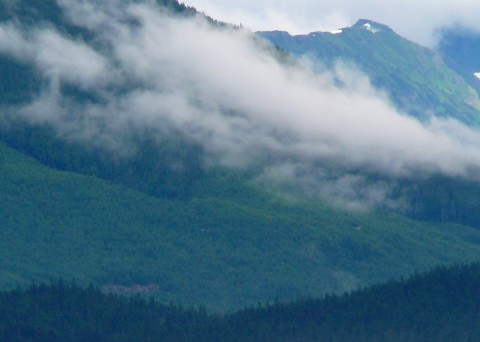
A clearcut north of Angoon is green with small second-growth trees. Environmental groups are calling for an end to old-growth clearcuts. (Ed Schoenfeld, CoastAlaska)
The Tongass National Forest is in the crosshairs of environmental organizations again. Two large coalitions are pressuring the Obama administration to stop all old-growth logging, in part to fight climate change.
The Sierra Club, Alaska Wilderness League and Natural Resources Defense Council are among the groups calling for an end to old-growth clear-cutting in the Southeast Alaska forest.
At the same time, 60 organizations acting as the Federal Forest Carbon Coalition are calling for changes in forest management to address what they call “the climate crisis.”
“It turns out that the Tongass is a globally significant carbon storage reserve,” says Malena Marvin, executive director of the Southeast Alaska Conservation Council, one of the groups involved in the issue.
She says the Tongass is important on a global scale.
“It turns out that big, wet forests store more carbon than any other type of forest. So the Pacific Northwest and Alaska rain forests really do more to combat climate change than any other forest in the country,” Marvin says.
SEACC and the other groups say logging should be better balanced with the needs of tourism, fishing and recreation.
The groups say old-growth timber cuts should end within five years, rather than the 10 to 15 years the Forest Service plans. They also say second, or young, growth could better serve smaller mills producing lumber and other wood products.
“It’s really unsustainable and incompatible with other uses of the forest. And (it’s) really more akin to mining than it is logging in the sense that it’s not a sustainable way to form the base of a timber economy that benefits local people,” Marvin says.
“It’s very disappointing that they’re finding more ways to stop progress in Alaska,” says Shelly Wright, executive director of the Southeast Conference, which advocates for economic development in the region.
She says the remaining mills – one medium-sized and a couple that are smaller – employ a fraction of the number of people working during the Tongass timber boom.
But there are still some jobs with wages that can support a family.
“Pretty soon there’s going to be nothing. All of the infrastructure is failing. It’s very, very expensive right now because we don’t have the volume for transportation. So, it’s going away. It’s rapidly going away,” Wright says.
The Southeast Conference and SEACC are among groups wanting change as Tongass managers rethink their forest plan.
Fifteen people were recently named to an advisory committee assisting with those changes. But shortening the transition time, as the environmental groups want, may not come up.
“I’m sure it’s possible. The question will ultimately be, are people comfortable with the consequences of that,” says Tongass Deputy Forest Supervisor Jason Anderson, federal liaison to the advisory committee.
“That 10- to 15-year time frame is the direction that the secretary (of agriculture) has provided. If there are those who wish to see it sooner, I’m not sure if the (committee) will grapple with that dilemma or not,” he says.
The panel’s first meeting is Aug. 6-8 at the Best Western Landing Hotel in Ketchikan. It will mostly be organizational, but about a half-hour of public comments will be taken at the start of the Aug. 7 session. (Read the agenda.)
































